Chevrolet Captiva Service & Repair Manual: A-Pillar
| Section in specified areas only.
Sectioning outside of these areas may compromise the structural integrity
of the vehicle. The door frame can be replaced at factory seams, but requires
the removal of the windshield and the roof. The sectioning procedures have
been developed as a more cost effective alternative to complete replacement.
The specific area to be sectioned is determined by the extent of the damage
to the vehicle. |
| Warning: Foam sound deadeners
must be removed from areas within six inches of where flame is to be used
for body repairs. When installing foam sound deadeners, avoid inhaling fumes
as bodily injury may result. |
| Do not damage any inner panels
or reinforcements. |
| In any area damaged beyond recognition,
or if structural weld thru adhesive is present, space the plug weld holes
1 1/2 inches apart. |
| To create a solid weld with minimum
heat distortion make one inch stitch welds along the seam with one inch
gaps between. Then go back and complete the stitch weld. |
Removal
| 2. |
Disconnect battery ground. |
| 3. |
Remove all related panels and components. |
| 4. |
Repair as much damage as possible to
factory specifications. |
| 5. |
Remove sealers and corrosion protection
materials from repair area. |
| 6. |
Remove front upper rail as outlined
in Upper Frame Rail. |
| 7. |
Cut panel where sectioning is to be
performed, Fig. 1. |
| 8. |
Locate and drill out all factory welds.
Note number and location of welds for installations of service component,
Fig. 2. |
| 9. |
Remove damaged A-Pillar. |
|
Installation
| 1. |
Cut replacement windshield pillar section
in corresponding locations to fit original panel. Sectioning joint
should be trimmed to allow 1 1/2 times metal thickness at sectioning
joint. |
| 2. |
Create a 2 inch backing plate (1) from
unused portion of service component. Trim backing plate as required
to fit behind sectioning joint where there is no reinforcement,
Fig. 3. |
| 3. |
Drill 5/16 inch plug weld holes along
sectioning cut on remaining original component. Locate these holes
1/2 inch from edge and spaced 1 1/2 inches apart. |
| 4. |
Drill 5/16 inch plug weld holes in
service component as required in locations noted from original panel
and along sectioning cut, Fig. 4. |
| 5. |
Prepare all mating surfaces as required. |
| 6. |
Apply 3M® Weld Thru Coating P/N 05916,
or equivalent, to all mating surfaces. |
| 7. |
Fit backing plate (2) halfway into
sectioning joint, clamp and plug weld to vehicle, Fig.
5. |
| 8. |
Position service component. |
| 9. |
Plug weld accordingly, Fig.
6. |
| 10. |
Stitch weld sectioning joint. |
| 11. |
Install front upper rail as outlined
in Upper Frame Rail. |
| 12. |
Clean and prepare all welded surfaces. |
| 13. |
Apply sealers and corrosion protection
materials to repair area, as required. |
| 14. |
Refinish repaired area. |
| 15. |
Install all related panels and components. |
| 16. |
Connect battery ground. |
|
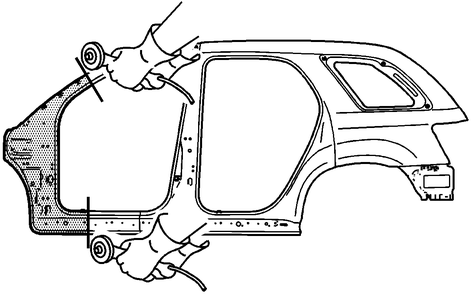
Fig.
1 A-Pillar cut locations
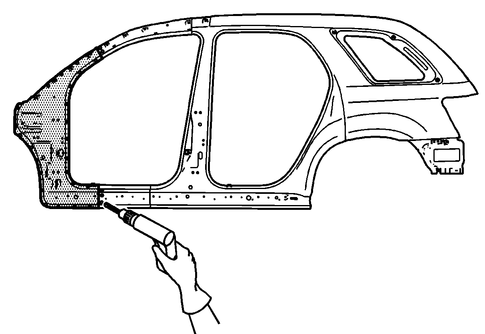
Fig.
2 A-Pillar weld locations
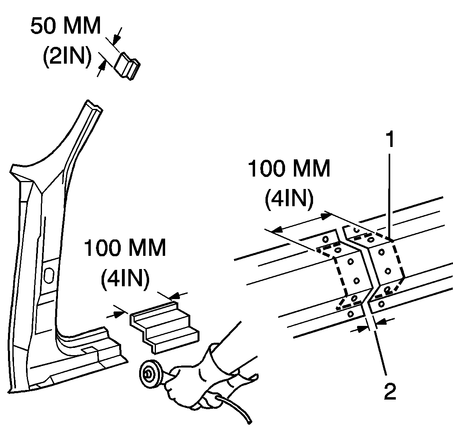
Fig.
3 A-Pillar backing plate
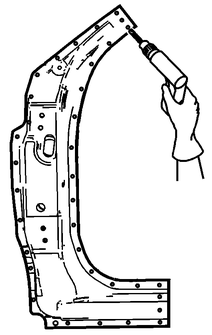
Fig.
4 A-Pillar preparation
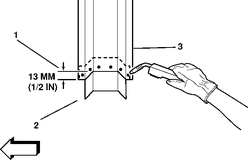
Fig.
5 A-Pillar backing plate installation
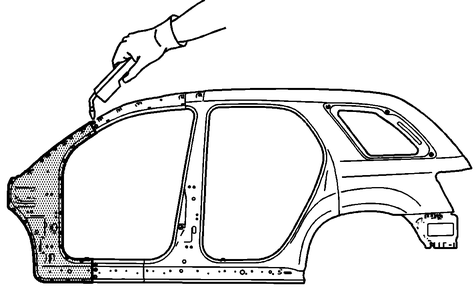
Fig.
6 A-Pillar plug weld locations
Servicing the A-pillar of a 2006-2018 Chevrolet Captiva, which spans from the vehicle's roofline to the top of the front fender, involves careful removal and installation to ensure structural integrity and proper fitment of components such as airbags, trim panels, and wiring.
To begin the removal of the A-pillar trim, first ensure the vehicle is parked on a level surface and the ignition is off. For safety, disconnect the negative terminal of the battery, especially if your vehicle is equipped with side curtain airbags housed within the A-pillar. Carefully pry off any plastic covers or trim pieces using a trim removal tool, starting from the top and working your way down. These covers typically conceal screws or clips that secure the trim panel to the A-pillar structure. Once the covers are removed, locate and remove the screws or gently release the clips holding the trim in place. Be mindful of any wiring or airbag components as you detach the trim panel. If the vehicle is equipped with an airbag, carefully disconnect it following the manufacturer's guidelines to avoid triggering deployment.
Installing the A-pillar trim involves reversing the removal process. Begin by carefully aligning the trim panel with the A-pillar, ensuring all clips and screw holes are properly aligned. If you disconnected an airbag, reconnect it securely, ensuring all connections are tight and in compliance with safety protocols. Once the trim is aligned, press it into place to engage the clips, and then reinsert and tighten the screws. Replace any plastic covers or trim pieces that were removed earlier, ensuring they fit snugly and securely. Reconnect the negative battery terminal and test the integrity of the installation by checking for any loose components or misalignments.
By following these steps, you can effectively remove and install the A-pillar trim in a Chevrolet Captiva, ensuring all components are securely fastened and properly aligned. This process helps maintain the structural integrity of the vehicle and ensures that safety features, such as airbags, function correctly.
Section in specified areas only.
Sectioning outside of these areas may compromise the structural integrity
of the vehicle. The door frame can be replaced at factory seams, but requires ...






 Body & Frame
Body & Frame B-Pillar
B-Pillar